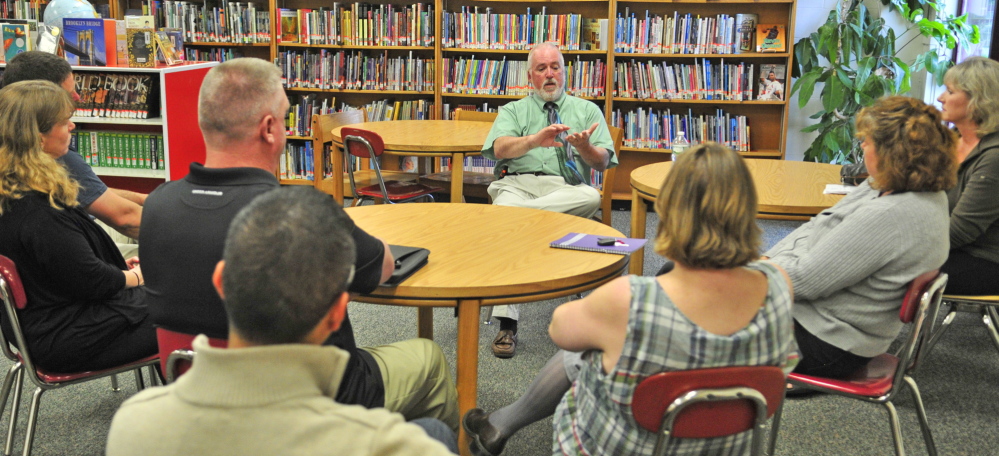RICHMOND — The principal of Richmond high school and middle schools invited parents to the school Thursday night to explain why the high school received a failing grade and the middle school a low grade, and what administrators intended to do about it.
“We knew in September it was coming, but to see it in this format is a little difficult,” said Principal Steven Lavoie. “It’s a snapshot in time. We are a small school, our data is vulnerable to swings.”
The school has on average about 30 students in each grade. However, he acknowledged, “Our performance on the SATs was horrible.”
Those tests were taken last year by students who are seniors this year.
This year, all juniors were required to take a twice-weekly SAT preparatory class, and he expected to see improved scores as a result on the SATs they just completed.
He told the handful of parents that the move to proficiency-based learning will begin to show improvement as will the addition of another math teacher for the fall of 2014, and a skills lab offered by each math teacher.
Vergil Hammonds, superintendent of Regional School Unit 2, told parents the district is looking at using federal money to add a literacy coach.
In 2013, Richmond schools earned a C, or average grade.
Several of the parents disagreed with this year’s F grade, and said the school is improving.
“I have seen a lot of change for the better,” said Therese Acord, who has two children in high school and a third who graduated last year. “Richmond High School has come a long way in the five years I’ve had a child here.” She also said the parents have to step up as well.
Tamara Smith said good things were happening in the middle school, where she has a son. “I think recently what’s happened is good. You can’t change the Titanic all at once.” The middle school received a D this year.
Hammonds’ note to parents said, “There is so much about Richmond Middle/High School that is positive, to receive this label is difficult for we are not a âfailing school’ as this report card describes us. I encourage you to stop by this school on any day to see the work that our students and staff are doing both in and outside of our classrooms.”
Hammonds came to the Richmond parent meeting directly from Camp Kieve leadership school in Nobleboro, where he was visiting with some of the district’s students.
“We clearly have to continue to improve and continue to hold our kids to high standards,” he said.
Another high schools in RSU 2, Hall-Dale received a D, Hammonds said, because it was docked for a lower SAT participation rate. The state education department counted two students who had left the school six months earlier, and Hammonds said the school is seeking to get that deduction voided, which would result in a grade of C. Monmouth Academy received a C.
But the measurement still rankled.
“If I gave one test to my students and that counted as the grade for my year, would that be the fairest indicator of what my kids know after a year,” Hammonds ask. “That doesn’t make sense.”
At the high school the assessment is based in large part on SAT participation and scores and at the middle school on the New England Common Assessment Program particpation.
At Gardiner Area High School, Jean Bulley of Gardiner was satisfied that Gardiner had improved its rating to a C. On Thursday afternoon, she watched her son, junior Casey Bisbee, compete in a tennis match. She praised the school for the way it helped Casey after his father died in November. “They’ve all come together and helped him a lot and I think that’s very good for a school.”
Matthew Weed, of Pittston, also a junior at Gardiner Area High School, was also pleased to hear that Gardiner’s rating had improved based partially on the SAT participation.
“English was a big part of the SATs,” he said. “Mrs. (Rie) Kittredge, department chair, was a big help in motivating kids to do their best. She set up 40-minute writing prompts, that would help kids analyze reading passages.”
In Augusta, Cony High School junior Steven Beland said when the high school received a C last year, he thought they could do better. He said students feel their school is good and getting better, and they’ll be happy about the B.
“I think it’s very helpful to record how we’re improving,” Beland said. “It’s going to improve our confidence that much more.”
Sophomore Tynisha Francois said the report card system is valuable.
“I like it because it pushes us to work hard,” she said. “I’m hoping that when we get to be seniors, we’ll step it up and hopefully get an A.”
Karen Zembroski of Farmingdale, said school performance and academic choices were major factors in choosing to enroll her son Kyle at Erskine Academy — which has received a state grade of B for the second year — even though his older brother Kevin was valedictorian at Hall-Dale High School in 2012.
The family pays tuition so Kyle can attend a school outside his home district, and reviewed the graduation rates and course offerings at all the school in the Kennebec Valley before choosing the academy in South China.
“We felt that Hall-Dale was going through internal changes serving their academic program,” she said. We wanted our son to be in a school that had more offerings in leadership, art and music.”
She said several of her friends pay attention to the state report cards for schools.
Staff Writer Susan McMillan contributed to this story.Betty Adams — 621-5631 | badams@centralmaine.com | Twitter: @betadams
Copy the Story LinkSend questions/comments to the editors.





Success. Please wait for the page to reload. If the page does not reload within 5 seconds, please refresh the page.
Enter your email and password to access comments.
Hi, to comment on stories you must . This profile is in addition to your subscription and website login.
Already have a commenting profile? .
Invalid username/password.
Please check your email to confirm and complete your registration.
Only subscribers are eligible to post comments. Please subscribe or login first for digital access. Here’s why.
Use the form below to reset your password. When you've submitted your account email, we will send an email with a reset code.